

Ramya Gurunathan - NanoJapan 2014
Pennsylvania State University
Major: Materials Science & Engineering
Class Standing: Sophomore
Anticipated Graduation: May 2016
NanoJapan Research Lab: Solid State Electronics Lab, Prof. Maki Suemitsu, Tohoku University
NanoJapan Research Project: ![]()
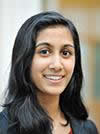
Why NanoJapan?
My interest in nanotechnology stems back to my junior year in high school when I became involved in a research project at Rutgers University focused on using gold nanoparticles for targeted drug delivery. It became evident to me that the ability of scientists to see and manipulate objects at the nanoscale was really changing the game of material selection and device design. I continue to be attracted by this idea and have only grown more eager to understand the quantum phenomena that govern these nanoscale material systems. Therefore, the research focus of the NanoJapan Program immediately piqued my interest. Additionally, I have also learned from my experience with undergraduate research that good quality science does not occur in lonely labs behind closed doors. It instead requires collaboration across a global scientific community. NanoJapan seems to offer the opportunity to sharpen both my skills in research and my skills in adapting to a different culture. In addition to the research, I am deeply excited to experience Japan’s spectacular culture, arts, and landscape.
There are so many aspects of this program that I am looking forward to. I think the work will be exciting as it will give me the chance to explore materials like graphene and carbon nanotubes with highly unique electronic and mechanical properties. On top of this, overcoming cultural barriers in order to complete this project in an international setting will undoubtedly provide a lot of personal growth. During my time in Japan, I really hope that I will be able to explore the local culture both in the cities and hopefully in the surrounding areas. Additionally, I am all too eager to explore the landscape of Japan, and was more than thrilled to see that an overnight hike of Mt. Fuji was a suggested activity in the program.
My goals for this summer are to:
This has been a whirlwind of week, and it now makes a lot of sense why these reflections are built in to the program. Taking the time to sort through everything I’ve done and seen will actually be pretty invaluable. It is hard to believe that just a week ago I was sitting on the 13-hour flight from Houston literally squirming in my seat because of the anticipation… and leg cramps. I could not really grasp the fact that I was going to be living in Japan until the bus ride to the Sanuki Club when I could finally see massive skyscrapers pop up around us and begin to take in the magnitude of Tokyo. This week alone I have visited Shibuya, Shinjuku, Akihabara, Asakusa, Kamakura and I have gone up the Tokyo Tower. I have gone from not knowing a lick of Japanese to being somewhat functional at the restaurants and kombinis. And, I have explored nanotechnology research facilities both in the industrial setting and at the universities. What has stood out the most about Tokyo has definitely been the scale for me. Going up Tokyo tower put this into perspective more so than anything else.
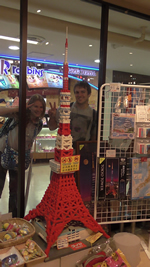
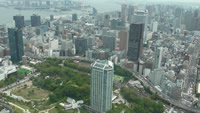
Vernon and Nicole posing behind a LEGO replica of the Tokyo Tower along with a picture taken from the tower.
In Shibuya, we frantically walked across the intersection that has the most foot traffic in the world, and in Shinjuku, we visited the busiest subway station in the world. Luckily though, even after getting lost in a sea of people, it is fairly easy to pick out the group somewhat dazed and overwhelmed American students, so we never had a problem regrouping. In Shinjuku and Akihabara, we visited stores with 10-12 floors in total that are just packed with a million different types of cellphone accessories, appliances, game consoles, and any other electronics you could think of. These types of stores, decked out in brightly colored signs and lights, crowded the streets of these districts. These areas reminded me somewhat of the shopping districts in major Indian cities like Chennai and Mumbai, but I think Tokyo still outdoes anything I have seen before in terms of magnitude.
Our night out in Akihabara on Friday is one that I will certainly never forget. I joined Ben 10 and Chris M., two anime enthusiasts, and we traveled between various figurine stores and arcades, running into not only tourists and teenagers, but even business professionals still donning their suits from the day. We entered one café and were met with an explosion of all things pink and fuzzy. As advertised, the waitresses made the ice creams we ordered even more delicious through their “magic songs and dance.” I am so happy that I summoned the courage to tell them that is just happened to be Ben 10’s “tanjyobi” or birthday. Towards the end of our meal, the lights suddenly went off and the disco ball turned on. Ben was dragged onto stage and we all sang a few sprightly birthday jingles for him. The whole experience was pretty sensational, which is the word I would use to describe much of what I have experienced in Tokyo this past week.
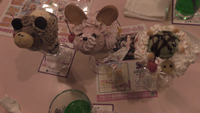
As with much of what we saw in Akihabara, these ice creams were delightfully over-the-top.
The language classes have been fast-paced, but I am really glad that we have them. I have decided already that I would like to find a way to continue learning Japanese in Sendai during my research internship and then hopefully continue learning back at Penn State. Many of the signs have English as well as Japanese, but it is fun to read the names of Subway stations in hiragana or to read items off of a menu in katakana. I have never experienced this type of intensive language study, and I find that I really do have to take the time to come back and study before I go to bed in order to keep up with the lessons.
This week has also given us a glimpse of science in Japan through the lab visits at To-Dai, the lecture by Paul Fons from AIST, and the visit to Elionix. During the visit to To-Dai we saw two chambers used to study the physics of BEC which reach temperatures on the order of milli-Kelvin. At Elionix, we saw an electron beam lithography unit that could pattern feature sizes as small as 0.01 nm. It became evident to me that Japan is innovating for the 22nd century with some of their solid state materials research. After each of these tours and seminars I ended up with a list of new topics in nanotechnology that I need to Google.
Finally, this past weekend between the Sumo match and the trip to Kamakura has provided a much needed glimpse into traditional Japanese culture which I am eager to study further. One question that has been buzzing in my mind at the end of this week has been in reference to the younger generation’s connection to their traditional Japanese roots. I know when I travel to India it is sometimes disconcerting to see the Westernization of the younger generations and their detachment from the unique Indian art forms and cultural practices. As I move onto Week 2, I would like to find out whether Japanese youth are experiencing the same shift in culture or if they are more steadfast in their adherence to traditional Japanese customs.
Research Project Overview at the Solid State Electronics Lab, Prof. Maki Suemitsu, Tohoku University
My research project for this summer will be centered on performing Monte Carlo simulations to model the 3D bulk properties in Silicon Carbide, namely the behavior of dislocations. Monte Carlo simulations are very potent computational tools and I have utilized them for projects in the past to determine the lattice structures of various materials. I understand that these computational methods rely on repeated random sampling. Silicon carbide is interesting as a wide-bandgap semiconductor. It has a high temperature tolerance, high breakdown voltage, and high stiffness with a Young’s modulus on the order of 300- 700 MPa. For these reasons, it is of interest for high-temperature, high-power, and high-frequency environments often achieved in aerospace applications, hybrid electric vehicles, and in industry-scale machining. (1) However, the leakage current in 3C-SiC MOSFETs is highly dependent on the defects in the material. Therefore, it is important to model the behavior of dislocations at various temperatures through these Monte Carlo simulations (2). Studying the line defects in the material will provide information about the electrical, optical, and mechanical properties of the silicon carbide crystals as a function of temperature. However, I believe my project will be primarily concerned with the electrical properties of silicon carbide and its performance in semiconductor devices.
People could probably write books on Tokyo “subway culture” alone. Especially during the day time, it seems like everyone is expected to maintain the highest degree of reticence possible even when packed between people. Conversations are kept to a minimum and at a low volume, and speaking on the phone is a major no-no! It is also really important not to eat on the subway or in the station. In fact, eating in a public place is simply not done here. I actually find it shocking how steadfast everyone is in adhering to this unwritten rule.
Early in the morning, during lunch hour, and around 5-6 PM, the subway is packed to its limits. I still have not had to get jammed into a subway/ rail car by train pushers, which I find both relieving and maybe the slightest bit disappointing. In order to accommodate maximum space, people keep briefcases and bags tightly packed against them. Nearly everyone you see is either sleeping with their head simply and neatly slouched forward, looking at their phones, or reading a book. It is somewhat amusing to occasionally see the young, more rebellious boy or girl breaking some of these norms by speaking on the phone or even eating on the subway, but I could count the number of times I’ve seen something like this on one hand.
On the nights when we took one of the last rails home, some of the rules relaxed a bit. People tended to have louder conversations and spread themselves out a bit, but this was only natural since the subway was not filled to its maximum capacity. In general, I have noticed that people in Japan stand a bit farther away from the person they are addressing. If anything, it gives people room to bow when they greet the person they are talking to. But, in the subway or in the elevator, there seems to be no sense of personal space.
In all, the public transportation here is remarkable! The subway stations are marked by an orchestrated chaos that may take a couple of tries to fit into. I learned quickly to stand to the left of the escalator and to run down the right side if I was in a hurry. Also, it is important to fish out your Passmo card in advance so you don’t embarrassingly hold up the foot traffic even for a second as you enter the platform. Efficiency is not surprisingly a large factor of Tokyo’s “subway culture.” Packard-sensei even showed us posters that show which subway car you should enter to end up close to the exit you need to leave from at your destination! She said a housewife came up with the system and received a reward for her work.
I have only really used public transportation that is anyway comparable to that of Tokyo during occasional visits to New York City. Even though Tokyo’s subway system is massive and hectic, I feel so much more comfortable navigating the subway here than I do in New York. I think it has a lot to do with how safe you feel here. I would be too scared to fall asleep on the subway in NYC for fear of having something stolen, however, I do not feel that same weariness here in Tokyo.
Considering the number of people who rely on the public transportation here, it runs like a well-oiled machine. This reflects the importance of avoiding conflict and public disruptions in Japanese culture. The setup of the public rail system assists with this by maintaining high efficiency and timeliness. Additionally, the public helps to avoid conflict by maintaining a high degree of respect and a generally non-confrontational demeanor. The subway has really helped me see that aspect of “situationalism” in Japanese culture. Even in the arguably more demure Japanese culture, there is a time and place to be big, bold, and outrageous. Trips to Shinjuku and Akihabara have made this entirely evident to me. However, on the subway, everyone maintains a high degree of professionalism, cleanliness, and quietude.
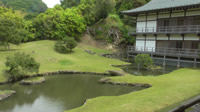
Gardens behind a Zen Buddhist Temple in Kamakura
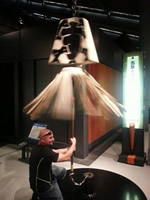
Chris Salinas: Nerdy science student turned epic ancient Japanese firefighter
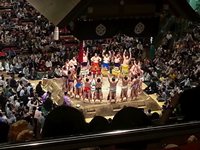
Opening ceremony to final portion of the Sumo Tournament
Intro to Nanoscience Lectures
Unfortunately, I had a conflict on the day of Prof. Bird's first lecture and was only able to attend the last 20 minutes. However, I did review the slides and the notes from other students. After doing so, I was really upset that I missed the lecture because it seemed to give a very comprehensive view of the theory and application of Solid State Devices. One thing I was wondering about p-n junctions is whether the devices can be described by some characteristic capacitance. When looking at the diagram of the device, it reminded me of a parallel-plate capacitor with the depletion zone functioning as an insulating, dielectric material and the build-up of positive and negative charges around the depletion zone functioning as the electrodes. Is it appropriate or useful to think of p-n junctions in this way?
In Prof. Bird's lecture on graphene, I particularly enjoyed the discussion about why it is challenging to use graphene as a material for transistors. I had been used to seeing graphene portrayed as the wonder material which would replace Silicon in as the premiere material for semiconductor devices. However, I did not really know what was getting in the way of graphene-based transistor devices.
I thought Maruyama-sensei’s lecture was extremely interesting, and it surprised me to find out that so many of the synthesis techniques he uses for carbon nanotubes and graphene are still not well understood. I would be interested to find out the physics behind the octopus method and the Cu-substrate CVD once it is better understood. I really enjoyed the discussion about carbon nanotubes, as I had not realized that their electrical properties were so highly dependent on chirality and diameter. It was interesting how Maruyama-sensei described the band structure of the carbon nanotube as a “cross-section” of graphene’s band structure. If the cross-section is taken at the intersection point of graphene’s band diagram, then the carbon nanotube will be metallic, otherwise it will be semiconducting. This seems to provide a great deal of flexibility when working with the material.
I also really enjoyed Ishizaka-sensei’s lecture mostly because it was about something I had never heard of. This made it much more difficult to follow, but I also now have a solid list of new topics that I want to Google including the Rashba effect, ARPES, high harmonic generation using high density gas, and spin-splitting in materials. From this lecture, I have come out with the realization that ARPES is a valuable tool because it gives a really complete description of the electrons in a material by determining their energy, momentum, and spin. Additionally, I learned that realizing spin-controlled devices will require achieving high levels of spin-splitting in materials. I am curious to know how far scientists are from creating functional and useful spin-controlled electronic devices. I would like to do more research in spintronics to see how far scientists have progressed in this field.
Even having just returned from Kyushu, I already miss it terribly. It was hard to believe that the green mountain tops, unending fields of o-cha, and terraced rice paddies were even real. I feel like I accidentally jumped into a postcard or calendar last weekend. The more bucolic feel of Gokase was a really great alternative to the hustle of Tokyo. For all of the students surprised by just how westernized Tokyo is, Gokase gave them a taste of the Japan they really expected.
But more so than the landscapes, it was the people we met that made the trip especially memorable for me. It started with the children at the kindergarten who immediately flocked to each of us with unabated enthusiasm. After a couple of rounds of a duck-duck-goose-esque game, some sharing of Japanese and English nursery rhymes, as well as spontaneous demonstrations of dance, acrobatics, and magic tricks by myself and a bunch of the other students, it was hard to separate ourselves form the kindergarteners. This was particularly difficult for Vernon who seemingly out of nowhere got ambushed and knocked to the ground by about 20 kindergarteners. I, myself, was followed out of the classroom by one little girl who I got particularly attached to. It was pretty hard to say goodbye.
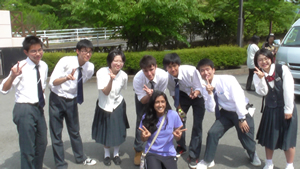
Just a few of the Gokase Secondary School students who I became best friends with in just a single weekend.
More so than anyone else though, I got extremely close to the students at the Gokase Secondary school. Although a few joined us for Kagura, I got the chance to really interact with them when making straw sandals. Honestly at first it felt really awkward. I felt worlds away from the students and there was a hefty language barrier, so I resorted to making really broken up small talk. The conversations hit frequent lulls and we spent many painful minutes of silence just staring at each other. But, this was broken when one of the girls asked me if I liked One Direction and then another asked me if I had a boyfriend. This opened the floodgates and within minutes we were knee-deep in girl talk. I realized that the anxieties and angst and hopes and dreams shared by these girls exactly paralleled how I felt at their age. It seems that teenage angst knows no cultural boundaries. Likewise, the boys from Gokase were all too willing to boast about their athletic abilities and demonstrate how much faster than are than me by racing. It was painfully difficult to say goodbye to the Gokase students, and some of the girls came up to me at the end and said “Ramya-san, you are only here for one day. I do not want you to leave.” That was way too much to hear, so I ended up getting the mailing addresses of about five different students who I promised to send letters to. I have friends on the floor of my dorm at school who are interested in starting a pen pal program and I think this might be absolutely perfect!
I also find myself itching to go back to my homestay family. It was not highly surprising that I stayed with an older couple for the homestay. In general, I learned that Gokase has a large aging population. When I first arrived at the Teramoto household, their granddaughter, Mikoku, was visiting and was ready with little anime, princess trinkets to give to Yu-san, Misari-san, and myself. We then got ready for dinner which lasted from 6 PM all the way to 9:30 PM. That night, I ate enough for about 10 people. My host family was so concerned that I would not get enough good food to eat as a vegetarian in Japan, so they seemed to want to make up for it by preparing 12-15 different vegetable dishes for me that night. Of course, I had to try a little bit of everything, so I ended that night bursting at the seams after trying vegetable tempura, somen Japanese noodles, mushroom soup, five different kinds of greens, bamboo salad, edamame, as well as a whole bunch of veggies that I could not even name. Throughout the dinner, I had to continually console my host family, so that they would not feel bad about eating meat around me. Yu-san, Misari-san, and my host family indulged in crab legs, the freshest fish you can buy, beef, and at one point my host mother even brought out fried bees!!
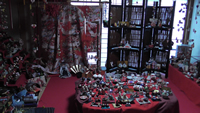
Host family’s room decorated for Hinamatsuri
On the first floor of my host family’s house, they had an entire room devoted to Hinamatsuri or Girl’s Day. The room was filled with 200-300 figurines which my host mother had been collecting for about 15 years. As part of Hinamatsuri, families place figurines on a platform with steps. The first step has an emperor and empress, then comes three maids, and finally five musicians. I was so surprised to see this arrangement because in Hindu culture we arrange dolls in a very similar fashion to celebrate Navaratri which is also a festival celebrating girls. It was so interesting to see this parallelism between the way women are celebrated in Japanese and Indian culture!
The KIP (Japanese) students definitely helped to bridge the language barrier, but it was still a challenge for me to speak up. Naturally, the KIP students and the host family would break into conversation about Japanese topics that I had no background in like certain traditional foods or holidays or games. A large part of me felt like piping in to ask a question would be disruptive to the conversation, and I really did not want to intrude on these moments that the KIP students and the host family were sharing. I would force myself, however, to regularly ask questions because I realized that as an outsider looking in, I could really learn the most from these conversations. Of course, my questions were met with a lot of enthusiasm and both my host family as well as Yu-san and Masuri-san were more than eager to share. By the end, I no longer felt like an outsider, and I ended up sharing a lot about myself too. I told my host family about my family, my hobbies, and even gave them a copies of brochures from my dance performances that have pictures of me in the Classical Indian dance costume. Mrs. Teramoto was pretty ecstatic.
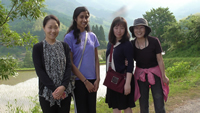
Yu-san, Matsuri-san, Mrs. Teramoto, and myself during our morning walk around the picture-perfect Gokase.
Before leaving for Kyushu, Packard-sensei talked about the “inside” and “outside” element to Japanese culture. By entering the Teramoto home, I felt like I immediately became part of the “inside” and part of the “we.” Mr. Teramoto even took us to see their family temple on Sunday morning. I appreciated this gesture fully because I know that in India, our family temple is an integral part of the community we share. This weekend reminded me of something the representative at Elionix warned us of in our first week here. He told us that we would spend the first couple of weeks noticing the differences between American and Japanese culture, and then we would begin to realize that we are not so different after all. After meeting high school students who seemed to perfectly reflect myself in high school friends and after staying with my host family who reminded me so much of my own family, the commonality we share is all the more apparent.
Overview of the Orientation Program and Language Classes
I think the most helpful activity for me was the trip to Kyushu for a lot of the reasons I have described above. Essentially, the trip pushed me to try a lot of new things. It pushed me to practice my newly-acquired rudimentary Japanese skills, it pushed me to try new foods and new activities, and it pushed me to connect with people who have been brought up with a different set of cultural values. Contrarily, I don’t feel that I fully took advantage of the cultural lecture with the representative from the Tokyo Office of the NSF. It was the day after we landed, and we were all visibly jet-lagged. Because of this, she did not go into much depth about her experiences in Japan as a foreigner.
In language class, it really helped me when we were given scenarios like “Mr. Smith is going to Shinjuku tomorrow to buy his mom German chocolate,” and were asked to translate because it helped me learn sentence structure. It was difficult when we learned 20 new verbs in ne class because they were hard to internalize. I recommend compiling a list of the particles you learn and listing the cases in which you use them because this will help you notice patterns. Creating flash cards for hiragana, katakana, as well as adjectives and verbs can help. Try to read the hiragana and katakana everywhere you go and see if you can translate the katakana.
Something important I learned about Japan after coming here is the idea of the inside/outside aspect to the culture. The home is a very valued and sanctified place that should not be dirtied by elements from the outside. The biggest thing for travelers to remember in reference to this is always remove your shoes before entering a home!
Three burning questions about Japan:
How is there such a huge supply of tiny, purse-sized puppies in this country???
Are there any real problems with poverty and homelessness in this country? And if not, how is this maintained? Is there any government intervention?
We have visited several Shinto-Buddhist temples and shrines during that last few weeks. How connected are people to Shinto-Buddhist practices in day-to-day practice?
Intro to Nanoscience Lectures
In Stanton-sensei’s first lecture, he walked us through the interactions of light with semiconductor devices starting with basic quantum mechanical principles and ending with a discussion of modern LEDs, laser diodes, and PV cells. I am lucky to have just finished a course on the Optical Properties of Materials this past semester, so a lot of this information felt accessible to me. One piece of information that I did find extremely interesting was the Strain Silicon Technology introduced by Intel. I am curious to know why applying strain leads to a lower effective mass for the charge carriers. I was also wondering whether the OLEDs and PLEDs are based on crystalline or amorphous organic molecules and polymers. If you use amorphous materials to create heterojunctions, is there still some sort of “lattice matching” requirement that you need to consider when choosing materials or does this just go out the window?
Stanton-sensei’s second lecture detailed the theory behind THz spectroscopy. I was particularly interested in the Gunn effect and the manner with which high voltages can excite electrons to higher energy “valleys” in which they have a higher effective mass, thus reducing their mobility. However, I still do not quite understand how this allows semiconductors to produce microwave oscillations by applying a DC voltage.
My favorite part about Otsuji-sensei’s lecture on graphene-based THz lasers was probably the analogies he used to describe physical phenomena. For example, he described the phenomena of spontaneous and stimulated emission in lasers using the popular Japanese gambling game, Pachenko. Through a virtual game of Pachenko, we could see how electrons in the excited energy states decayed either without any stimulus as with spontaneous emission or decayed after being “bumped” by an electron as with stimulated emission. I also really enjoyed the “domino” analogy he used to describe the slow-moving nature of plasmons. As with dominoes, each plasmon only has localized movement but this can translate to movement across a longer distance.
As I think back to my first day in lab, it feels a bit overshadowed by the day right before, the day I arrived in Sendai. I may or may not have misplaced my Shinkansen ticket on more than one occasion that day and then I after arriving at the apartment, I may or may not have angered the first new friend that I made by accidentally unplugging his computer causing him to lose unsaved work on his presentation. Somehow as soon as I left Tokyo, my head seemed to have gotten detached from the rest of my body putting a really rough start to my adventures in Sendai.
But, Monday was a new day, and after being greeted by a room of smiling faces and a resounding “Ohayo gozaimasu,” I felt a lot better. Everyone in my lab introduced themselves to me including the lab secretary, Kumi-san, my research supervisor, Nagasawa-sensei, the Co-PI Fukidome-sensei, a visiting scientist from Germany, Dr. Horn, and of course the students. I had met Suemitsu-sensei the day before when he picked me up from the Shinkansen station. The person I refer to directly for my project is Nagasawa-sensei who is extremely friendly and ready to offer a helping hand. On the first day, he helped me get my luggage back to my apartment, gave me a quick tour of Sendai, and later gave me a tour of the lab. Additionally, my grad student mentor, Tashima-san, is a second year master’s student. Although his English is more limited, we have still managed to bond over the fact that we are both really good at crashing and falling whenever we try to go skiing. On the first day, I also really hit it off with Mika-san, a first year master’s student, as we are both the only female students in the lab. Mika-san and I went to lunch together and talked about our hobbies, our family, and our friends.
Many of the students in the lab are not very comfortable communicating in English, but the professors, Suemitsu-sensei, Nagasawa-sensei, and Fukidome-sensei, all have extremely good English. Since Nagasawa-sensei is my main contact for my research, I don’t think communication will be too much of an issue. It has been a little more difficult to communicate my questions and suggestions than it might have been at home, but it’s only a minor inconvenience. Additionally, the lab has been very accommodating for myself and Dr. Horn, the professor visiting from Germany. During Monday’s group meeting, all of the students gave their research updates in English. Mika-san told me that they were all really nervous for this. But I though everyone did a really great job.
Living in the Urban Castle Kawauchi presents a couple of challenges, but there are certain things I really like about it too. On one hand it is very far from any sort of action, and it takes a good 20-30 minute walk to get to any decently-sized grocery stores or shops. But, on the flip side, in the first week I have already met people from Morocco, France, Spain, England, Bangladesh, India, the Czech Republic, and China. I have never lived somewhere with so much diversity. It feels a bit strange being the token “American” in the group. On top of that, everyone is involved in such interesting projects and seems to have gotten to Japan in some unique way. For example, two students are here working on a lunar rover for the Google X Prize. This is particularly exciting for me because I am just getting involved with Penn State’s Google Lunar X Prize team called the Lunar Lion. It is the only student-run team in the competition and the two students I met had actually heard about the Lunar Lion and were really eager to talk to me about it.
I have gotten going on my research project although it is going very slow at this point since there are many new topics that I have had to review. My project involves modelling the dynamics of stacking faults in 3C-SiC using Monte Carlo simulations. I feel fortunate that the classes I have taken recently have given me a lot of great background for this project. Somehow struggling through Crystal Chemistry, the Mechanical Properties of Materials, and Computational Materials Science all seems worth it now. The goals of the project seem fairly clear although there are details that I am a bit fuzzy about. As I get going on the project, however, and really begin to understand the inner-workings of the simulation software I am modifying, a lot of things are beginning to click. As of right now, my only regret is that I will not have time this summer to get my hands on any of the awesome lab equipment I was shown on the first day, and it is just a little disappointing that I will not be able to do any experiments while I am here. But, Nagasawa-sensei has promised to let me go into lab every now and then and at least spectate. Regardless, I can definitely rejoice in the fact that I have an interesting problem to tackle this summer!
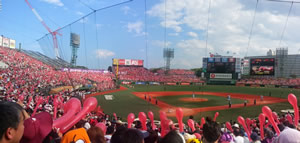
Fans getting ready to release their balloons during the 7th inning of the Eagles versus Giants game. Unfortunately, the Giants beat Sendai’s Rakuten Eagles 3-2 in the last inning.
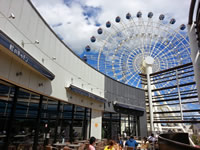
I took this picture while eating some Matcha ice cream near Sendai’s port. I have a feeling I’m going to like it here!

Took this panorama from the overpass near Sendai station. This was right before Ben F. and I got filmed for Sendai’s version of “Happy” by Pharrell Williams!!
Research Project Update
Research Project: My project will involve modifying simulation software which models stacking fault dynamics in 3C-SiC. 3C-SiC is interesting as a wide bandgap semiconducting material which can be utilized for high temperature, high power, and high frequency applications. For this reason, it will be a very important material for power switching in electric and hybrid vehicles. However, when 3C-SiC is grown epitaxially on Si, it develops many stacking faults which can inhibit the electrical properties of the crystal. Therefore, it is important to be able to model the stacking fault interactions in SiC.
The current model contains some errors and is only capable of modeling stacking fault growth and propagation based on partial dislocation glide on the outer surface of the (001) face of the crystal. However, a more comprehensive model of stacking fault dynamics can be acquired if dislocation glide in the body of the crystal is also accounted for. Therefore, my first task is to correct any errors in the program and incorporate dislocation glide in the bulk of the crystal. Additionally, my group is interested in studying the stacking fault dynamics on the (111) face of 3C-SiC. Therefore, my next task will be to modify the program to study the interactions on this face.
My primary goals for this project will be modifying the program to provide a more comprehensive model of stacking faults which incorporates the behavior of dislocations in the bulk of the crystal. In doing so, my goal is to draw conclusions about dislocation interactions on the (001) face of 3C-SiC. Subsequently, I will use this simulation software to study dislocation interactions on the (111) face of 3C-SiC allowing me to compare the behavior between the two faces.
Research Methods: For better or for worse, the only equipment I will really be relying on for this project is my laptop. The computational method I will be using is Monte Carlo simulation which relies on random probability to model a system. In this case, the randomization is biased by certain input parameters. For example, the user can specify the probability of spontaneous stacking fault generation or expansion.
Training: A lot of the training involved with my project entails gaining a solid background knowledge of crystallographic defects and the properties of SiC. Therefore, my research supervisor, Nagasawa-sensei, has agreed to give me lectures once a week on the basics on 3C-SiC. Moreover, I have been reviewing a lot of literature this week in the form of journal articles, PhD dissertations, and even textbooks which are related to stacking faults in SiC. Finally, the simulation software is all written in Pascal and C#, neither of which I have ever programmed in. Therefore, it will take some time for me to grow familiar with these languages. However, I have already noticed that they are very similar to JAVA which I have some experience with from high school.
Timeline: Nagasawa-sensei has already put together a rough timeline for my project. I have a task item for each week to assure that my project is completed in a timely fashion. This week has involved a lot of background research and some initial work on correcting errors in the source code for the simulations. Next week I will begin determining how to incorporate dislocation glide into the simulation. In my final week here, I have been tasked with giving a full 1-hour presentation on what I have learned and my findings. Therefore, I am confident that I will be ready and able to put together my poster by the end of this internship.
Questions or Issues: I suppose the only issue I had was some regret over not having the time to do any experiments or handle any of the equipment in lab. My lab is pretty well-equipped with about 4 different MBE systems, a few CVD chambers, clean room space, and more. However, I have voiced this concern to Nagasawa-sensei who has assured me that I will nonetheless be kept busy with my project, and that I will be invited to at least enter the lab and observe some of the experiments. This is pretty comforting, and I happy to have been handed an interesting problem. It seems difficult to get any conclusive results from experiments in only 8 weeks, but I can hopefully get somewhere with my simulations in that time.
I haven’t gotten myself in too much of a pinch during my time here so far, spare some miscommunications at the kombini. I have a really bad problem with mixing up verbs, so I have on occasion asked the cashier to “Show me a shopping bag” instead of “Give me a shopping bag.” Or there was the time I wanted to ask someone at a restaurant to please write down the name of a dish I wanted to order which would be “kaite kudasai.” But, I kept instead saying “kite kudasai” or “please come.”
I have also noticed that I have had to adjust a bit in lab, because the dynamic is a bit different. On my first day of lab, when I received a resounding “Ohayo gozaimasu!” from all of my lab mates as soon as I walked through the door, I thought it was just because it was the first time they were meeting me. I didn’t realize that everyone was greeted this way every day. And when anyone leaves lab, another chorus of “Ashita ja mata’s” can be heard. After two weeks, I still find myself kind of missing the cue. At my lab at Penn State, it would typically just be a “See ya” at the end of the day and maybe one or two people would chime in “See ya later” without really looking up from their work. And that was perfectly fine. I never really thought of our quiet, succinct greetings as rude. But here it seems important to take a second to look up from your work, direct a smile at the person entering or leaving the room, and take a moment to acknowledge them.
I think this is a reflection if the greater sense of community shared by this lab in comparison to others I have worked with in the States. And although it takes some getting used to, this extra friendliness is really comforting. I just feel a little pang of guilt when I am fixated on my code and kind of ignore lab mates entering and leaving. It is even worse when I have my headphones plugged in and miss these greetings altogether. I’ve noticed that I am the only one who has earphones in while working on the computers in lab. I realize that this can be a bit isolating, but I also know that sometimes the only thing that can keep me focused is the right playlist. I don’t want to close myself off from conversation or interaction in lab; however, especially when everyone else is so open. So, I have been trying to strike a balance by only listening to music when the lab is relatively empty.
Honestly, I’ve only had to make small adjustments while here. I remember during our visit to Elionix how the plant manager told us that we would discover more similarities than differences between Japanese and American culture during our stay here. I think this certainly rings true!
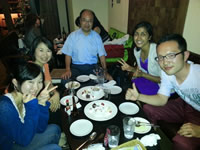
My welcome dinner with my sensei, lab secretary, and a couple of the graduate students! We had to walk about 40 minutes to get to a restaurant that had vegetarian options, but I think it was worth it! Just check out those desserts.
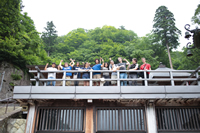
Our group at Yamadera including students from my lab, friends from Urban Castle, and Dr. Santos from the University of Oklahoma. After climbing the 1000 steps to the very top, we taught everyone how to strike the “Rocky” pose.
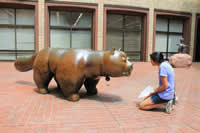
This is just me sharing a moment with the famous cat statue at the Miyagi Art Museum.
Research Project Update
This week I have gotten to work on modifying our simulation tool for modelling stacking faults in Silicon Carbide. My tasks for this week have involved making minor adjustments to the code so that it more accurately models stacking fault interactions on the (001) surface of SiC. I have also made modifications to make the simulation software more user-friendly, and added some extra functionalities which I will describe later.
My first task was to correct the “shrinking mode” interaction of two stacking faults. When a Si-face terminated stacking fault interacts with a C-face terminated stacking fault, the two should remain conjoined; however the computer model showed them detaching, so I modified the method which controls stacking fault movement to correct for this. Additionally, to make the simulation run more quickly, I added a function allowing the user to tell the simulation to only plot the stacking faults after every “x” number of cycles. Finally, the simulation originally only depicted the expansion of stacking faults, so I wrote a method that would allow it to handle the contraction of stacking faults as well.
Additionally, I spent a lot of time this week finishing the GUI (Graphical User Interface) and adding certain essential functionalities like a “pause” button which made it a lot easier to test out changes I have made to the program. I also added textboxes to the GUI which display the stacking fault densities for each type of stacking fault during the course of the simulation.
At the end of this week, I had a bit of extra time, and I had remembered that my sensei wanted to generate 3D maps of the partial dislocations in the crystals we are modeling. Partial dislocations are crystal defects which lie at the edges of stacking faults. Therefore, I decided to write some code that would collect the (x,y,z) coordinates of every stacking fault edge and store them in a text file. Then, I imported this text file into MATLAB to generate 3D maps of the stacking faults. On the GUI, I added the button “Growth with 3D Plot,” so that the user could generate a 3D map of their model if they chose to do so.
I think the difficulty in comparing research environments between different countries is that each individual lab is its own cultural microcosm. At Penn State, some labs maintain a more social, boisterous environment while other labs have a more sedentary, professional aspect. I think in Japan it is similar. Each lab builds its own culture. My lab has a very casual, open environment. Conversations about weekend plans and soccer games frequently break out in the office. The students and I freely talk to the senseis about academic and personal matters alike. I can imagine, however, that this may differ from lab to lab. Suemitsu-sensei is a very worldly and cosmopolitan individual. And I think the culture he has created in lab reflects this open-mindedness.
Kono-sensei and Dr. Fons told us to look out for a hierarchy in each lab. The “kun,” “san,” and “sensei” differentiation is maintained in the language used, but I don’t really feel the impact of this hierarchy all that much. In fact, I think I feel the professor-student separation much more at labs I have worked with in America. Here in Japan, I have frequently eaten lunch with my sensei and talked to him about my hobbies and my family. Additionally, Nagasawa-sensei works right next to me in the office itself, so sometimes he really feels more like a mentor than a boss. Contrarily, in all of the labs I have worked with in America, I only meet with the professor about once a week to discuss progress on my project. Again, however, I can’t say for sure that this ultra-friendly dynamic is maintained in all Japanese labs.
Additionally, each week students present a progress report at group meeting. This pushes them to work very hard because they should have results to report after each week. However, Suemitsu-sensei is very patient and accommodating especially since they have had to present in English these past few weeks while me and Dr. Horn from Germany are visiting. The students are certainly in lab or in the office for very long hours here, but they seem to use the lab as a study space as well. Since many of them commute from home, it is not like they can just run back to their dorm room to work on homework.
Something I have really enjoyed about this lab environment is the sense of community. The students in my lab seem to be really close friends. In the U.S., a person’s “professional sphere” and “social sphere” are often very disparate, but I think in Japan it may be more common for one’s work community to blend into one’s friend group. I honestly think this makes working in lab more enjoyable. As a result of this sense of community, an unwritten rule in lab is to always get everyone involved. Even for seemingly minor decisions like what to buy with some extra lab funding or where to go for the NanoJapan dinner, everyone gathers together in the middle of the office and adds their two cents about the topic.
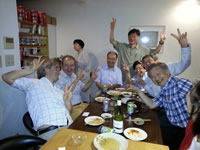
During the NanoJapan dinner, all of our professors decided to mock the way “we youngsters” take pictures. And who said the Japanese don’t have a sense of humor?
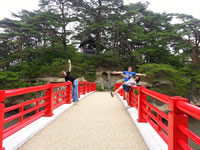
The woefully uncoordinated Sendai crew trying to keep their balance on one of Matsushima Bay’s many bridges.
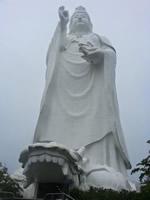
Staring up at the 3rd tallest statue in the world aka Sendai’s DaiKannon. Inside you can find 108 marble Buddha statues.
One of my biggest personal accomplishments this summer can be best described by a conversation I had with my dad last week. After detailing my recent successes with riding a bike to work and being able to cook a stir-fry for myself for dinner, I confidently told him, “I think I’m finally en route to becoming a fully-functional human being.” Indeed, beyond the research, I am thrilled that I will come out of this summer much more equipped to take care of myself. Additionally, navigating the Tokyo subway system by myself, planning the details for a weekend trip from start to finish, and maneuvering through airports with ease are just a few of my newly-acquired skills that I am sure will help me to become the world-traveler I hope to be.
On top of that, I am excited to think that my experiences in Japan have made me a little more bold and a little more adventurous. I keep surprising myself by trying things that I never thought I would just because I want to soak in every little bit of Japan that I possibly can before I go home. In fact, “When in Japan…,” has sort of become my slogan here, and I say this every time I’m about to do step out of my comfort zone. And well, it’s this mentality that has given me the courage to enter one of Akihabara’s maid cafes, get up close and personal with a Habu snake at the Ryukku Village in Okinawa, and get my face in Sendai’s version of “Happy.” Naturally, these have become some of my favorite memories from the summer so far!
I think a personal challenge of mine this summer has been having to question things I’ve always held for granted and justify things I always took to be absolute truths. This can be something simple. For example, I’ve had people ask why I say “Bless you!” after someone sneezes, and I’ve had to rationalize this behavior that I never even realized was quirky or strange. Or it can be pretty significant. Although I’ve lived my whole life as a vegetarian, I decided a couple weeks ago that it wasn’t worth trying to completely avoid fish broth here since almost everything is cooked with it. This has made me question why I am vegetarian and why it is okay for me to bend the rules under my given circumstances.
Finally, research is definitely progressing, although the looming deadlines are always nerve-wrecking. My first two weeks of research were very comfortable. I was progressing through my work a lot faster than my sensei had predicted. The task I am working on now has been a bit more challenging. Both my sensei and I thought it would be fairly easy code to implement, but there are a lot of little details that we did not account for. Last week, I really felt overwhelmed because there seemed to be so many little bugs to fix and my code was getting more and more complicated as I tried to address each of these issues. Now, I feel like a lot of it has cleared up, and in the process I learned a lot more about the algorithms I’m working with. However, I am still not entirely satisfied with my current position because there are still a few bugs to address. I anticipate that these last weeks of research will be much more intense. I think I got a little over excited in the beginning when everything was moving so quickly, so I signed up for language classes and planned a bunch of weekend trips. But now that things have gotten busier, I think I will have to work very hard to fit in my extra activities. Fortunately, I feel up for the challenge.
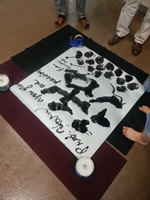
Mika-san from my lab gave us all an exciting and energetic “calligraphy performance” when Dr. Karsten Horn, a visiting professor from the Fritz Haber Institute, left Sendai. This was the final product!

I learned this weekend that I really, really like Okinawan dance. I’ve been contemplating pursuing an internship at OIST in the future…. aaannndd maybe I could tag on a few dance lessons too?
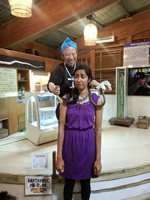
Look mom, I’m playing with super poisonous snakes in Okinawa!
Research Update
This week has been a little grueling because I have had to address a bunch of minor issues in my code in order to plot stacking fault interactions on the (111) face of SiC. In my last research report, I described the geometry I was striving to display through my program, and although I figured out how to map out the stacking faults, it has been difficult getting the stacking faults to interact properly. I think this has had everything to do with the fact that I am plotting 3D interactions in just two-dimensions, and it’s been difficult to understand the consequences of simplifications my sensei told me to make at the very beginning.
On the (111) face of 3C-SiC, there are three types of stacking faults that travel in the three different planes, however I am mapping this onto a two-dimensional square grid. Moreover, when the stacking faults interact with one another, they form junctions rather than annihilating each other. And this is why the problem has gotten so complicated for me. When a junction between two stacking faults forms, the direction in which that junction moves is a vector sum of the direction of each of the two stacking faults. Therefore, when I account for all of the potential junctions that can form, I have much more than just three planes of movement. If my three types of stacking faults are A, B, and C, then I am dealing with 7 different components in total: A, B, C, A-B junction, A-C junction, B-C junction, and A-B-C junction.
There were points during the week when I thought it might be worthwhile to code each one of these separately, but I think I’ve noticed some patterns that have helped me address a lot of my issues in a much more elegant way. Unfortunately, I am still working out some bugs, but I expect that by tomorrow I will be ready to present my solution to my professor. My only worry is that both my sensei and I thought this would be a fairly easy task, so I feel like I may have already spent too much time on this problem. I just did not expect that this problem would get so hairy.
Learning Japanese has certainly been a challenge, but I can’t say that I expected anything different. Fortunately, I think that I have had more opportunities to use my Japanese in Sendai because there seem to be less English speakers here. Moreover, there are less foreigners in this city, and I think because of that I have had more people try to strike up conversations with me in the elevator or on the train. I have to try really hard to figure out what they are asking me and how to respond. Often a lot of “Wakarimasen’s” and “Yukkuri onegaishimasu’s” are involved. I think my language skills after orientation were pretty rudimentary, but the basics that were covered have turned out to be extraordinarily useful. The international students who I sometimes go out to town with are always surprised by how much Japanese I manage to speak, and they are even more surprised that I only studied it for three weeks.
In Sendai, I have been taking a volunteer language class twice a week for an hour and a half each. My sensei is extremely capable and puts together really great lesson plans, but I feel like I haven’t been able to put in the time outside of class to really learn the material. As it is, devoting 3 hours to Japanese class has been a bit of a struggle. However, I try to pick at least some vocab words each week and incorporate them into my speech when I converse with my lab mates and secretary (for some reason, I am typically too nervous to try out my Japanese with my sensei).
I think the biggest miscommunication I have encountered was with my reserch sensei. He had asked a few weeks if he could sign me on as a co-author for a paper that he was presenting at a conference in France, but the way he worded this question was “Ramya-san, if it is good for you, I would like to invite you to join me as a coauthor for the ECSCRM paper.” He then shared the link to the conference schedule with me and suggested that I seek approval from my professors, which I took to mean asking them if I could miss class to attend the conference. This all made me think that I was being invited to go to France. Now, this is awkward because when I asked him about the registration deadline for the conference a week later, he gave me a very confused stare. I then realized that he was in fact just asking me to sign on as a coauthor which would entail filling out some copyright information and not booking any flights.
I think this miscommunication may have had to deal with two different language barriers, since my sensei is not very accustomed to speaking English and I am not very accustomed to speaking the language of academia. Therefore, I misunderstood what he was trying to communicate and I think he had difficulty formulating his request as well.
My experience in Japan has in fact motivated me to register for JAPANESE 100 at Penn State this fall. The class meets four times a week and the classes are each over an hour long, so it seems like a fairly rigorous course. I have come to the conclusion that if I am really interested in pursuing nanotechnology research, it will be worthwhile to learn Japanese. Additionally, I am very interested in maintaining the contacts that I have made here, and I think improving my Japanese will help me to do so. I think in addition to the university course, maybe joining in on some of the events held by the Japanese Student Society will help me accelerate my learning, so I am hoping I can make time for this during the semester.
The Mid-Program Meeting was beautiful and perfect in every way. Despite the humidity, I fully admit that Okinawa is paradise. Additionally, the Okinawa Institute of Science and Technology Graduate University visit really struck a chord with me. I think the mission of OIST is really cool and their commitment to linking different disciplines is really commendable. Therefore, I will probably be looking into internship opportunities during my senior year. My last few weeks will be kept very busy as I am only now starting to derive results from my simulations in lab. Moreover, I have so many last minute travel plans before I leave, so my mantra for these next few weeks will be “Work hard, play hard.”
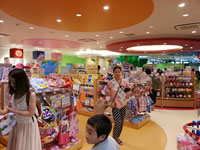
Jade, Ben F., and I located our inner five-year-old at Sendai’s Anpanman museum/ mall.
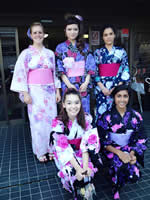
Finally got to wear a yukata for the Tanabata Party at Sendai’s International Center!!
Research Update
This week I completed the finishing touches on my simulation of stacking faults along the (111) face. This was really exciting for me because this was a task that turned out to be unexpectedly difficult and I had to make a lot of decisions for myself based on my understanding of the geometry of the 3C-SiC crystal.
My final simulation actually has triangular bounds with the sides of the triangle corresponding to the [0-1-1], [-110], and [101] directions which are the directions of growth for the three types of stacking faults in the (111) plane. Additionally, I was able to modify my code in order to account for junction formation which was the biggest challenge I had been facing the previous week.
My task for the coming week which I am starting to consider involves deriving plots of stacking fault density versus crystal thickness for both 3C-SiC oriented on the (001)-face and 3C-SiC oriented on the (111)-face and compare the trends for these two cases. Figure 2 shows an example plot of stacking fault density as a function of crystal thickness which I produced using MATLAB.
For these simulations, we want to vary the crystal size and see how this effects the results. Therefore, it is not necessary for me to apply periodic boundary conditions. I am a little concerned as to whether I will have to apply periodic boundary conditions in the future, however, because I am not sure how this will work with the triangular bounds. Additionally, I am a little bit worried about computation speed and memory space because we only feel comfortable trusting the results if there is a sufficient number of data points. Therefore, my sensei would be interested in having me make plots that are about 50,000 ![]() 50,000 unit cells. Being unable to store this amount of data, however, I will have to figure out what sort of simplifying assumptions I can safely make.
50,000 unit cells. Being unable to store this amount of data, however, I will have to figure out what sort of simplifying assumptions I can safely make.
As an aspiring scientist, it is easy for me to see the gravity of Obokata’s story. Being a young scientist performing research in the very “competitive market” that is stem cell research, the pressure to generate groundbreaking results is overwhelming. Maybe my anxiety over this issue is magnified by the fact that I am a female, but I think the pressure to publish is huge for anyone in research, and when this detracts from the quality of research it is a major problem.
Essentially, as I understand the issue, Obokata is a very bright researcher who just received her PhD. She published results that would have huge implications for stem cell technology to Nature. Her claims were significant and therefore her work drew a lot of scrutiny. From this, it was discerned that she utilized two figures that misrepresented her work. One figure was from a different study and therefore did not represent results from the experiment she was presenting and the other figure of a gel electrophoresis sample had actually been tampered with. Her employer, RIKEN, completed an investigation that found her guilty of misconduct. Obokata does not deny making the stated mistakes, but she denies any mal-intent, blaming the mishap on inexperience. Moreover, the investigation does not in itself suggest that her ideas are invalid, but the fallout prevents her from pursuing her work. Her work could not, however, be reproduced by other labs.
The pressure to publish was definitely at the heart of this issue. While the world of research may be intended to be “collaborative” and worlds away from the Social Darwinism of industry, it is definitely competitive. I think this must be especially true in the “hot button” subject of stem cell research. There are probably thousands of scientists around the world pursuing research in this field, and so the only way to really poke your head out of that kind of crowd is to have really earth-shaking results. So, while Obokata may have done some really constructive work, the need to be one step ahead of everyone else probably drove her to embellish her results.
I think the issue of gender mainly folded into the media’s response. The reason this story became so sensational was because Obokata was not just a scientist, she was a symbol of women in science. It is a hefty responsibility to bear and makes her a much more salient public figure. Professor Ishizaka from To-Dai who spoke to us in Tokyo put it really well. As one of the few female students in her program, she said that every time she did a good job everyone heard about it, but likewise every time she did not perform well everyone heard about it.
This whole issue kind of puts a bad taste in my mouth because while this was a very public case, I feel like there is quite often pressure to misrepresent research in less prominent ways. Last semester, I had a writing intensive Materials Science class in which every student had one week to come up with a Materials Science solution to one of the NAE’s Engineering Grand Challenges. Throughout the course we had to pitch our ideas in various ways by doing “elevator pitches,” white paper presentations, and even a full proposal. And throughout the course, ideas were continuously rejected until there was one winner left who got an A as well as $500. Additionally, they insisted that it didn’t matter what the actual idea was, but how you present it. Well, throughout the course, as I got the chance to do more research, I discovered that my initial idea was really ineffective in comparison to other alternatives. I ended up getting 2nd place with an idea that I am sure would not actually work just by focusing on my pitch. I felt pretty awful about the whole experience. But since I didn’t want to fail the class, I could not go up in front of the class and say “This week I realized that none of this will actually work,” which is really what I wanted to do. Science seeks the full truth, and therefore researchers are obligated to be entirely candid. However, fame and fortune are as great an influence in the world of research as anywhere else, and this can have profound impacts to the quality of science.
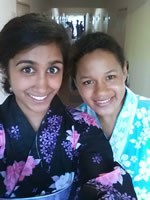
Jade and I in yukata!
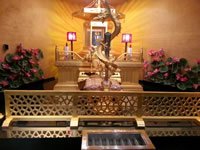
Daikannon Shrine
Research Update
This week I have worked on actually getting data from my simulation. I have been generating graphs which plot stacking fault density as a function of crystal thickness over the course of crystal growth. I have finished two different programs that I am working with, one plots stacking faults on the 3C-SiC(001) face while the other plots stacking faults on the 3C-SiC(111) face. Fortunately or unfortunately, actually running the simulations has made me aware of minor errors in my programs that I have needed to fix. So, I have had to redo runs a couple of times. The difficulty with this is that each of the simulations takes several hours to complete. The reason for this is that each grid point in my program, corresponds to about one unit cell. However, the crystal sizes that I am trying to model are on the order of microns. Therefore, the dimensions of my grid are very large, on the order of thousands. The result is a large number of grid points that need to be processed during every permutation.
I have completed my abstract for RQI and gotten in approved by my sensei. This is the final text for the abstract:
"3C-SiC has emerged as an attractive wide bandgap semiconducting material for high temperature, high frequency, and high voltage applications. It exhibits a low density of states at the 3C-SiC/SiO2 interface, making it a viable material for power-switching MOSFETs which are of particular interest to motor drives in electric vehicles. Moreover, 3C-SiC can be grown on a Si substrate to drive down production costs. However, as a result of the 19.7% lattice mismatch between Si and 3C-SiC, a high density of stacking faults are generated which can degrade the electrical properties and induce a high leakage current in 3C-SiC devices. Here we employ Monte Carlo simulations to better understand the interaction of stacking faults during epitaxial growth of 3C-SiC on a Si substrate. By modeling the generation, annihilation, and termination of stacking faults in 3C-SiC grown on the Si(100) face as well as the Si(111) face, we can compare the stacking fault density reduction mechanisms for both geometries. For both cases, we monitored the evolution of stacking fault density as a function of 3C-SiC film thickness for various different sizes of crystals ranging from 15![]() 15 µm2 to 1000
15 µm2 to 1000![]() 1000 µm2. In contrast to that of (100)-oriented 3C-SiC, the stacking faults on the (111) face have unified polarities which gives rise to increased annihilation. Therefore, we expect to see that the stacking fault density will decrease more rapidly in the case of (111)-oriented 3C-SiC growth."
1000 µm2. In contrast to that of (100)-oriented 3C-SiC, the stacking faults on the (111) face have unified polarities which gives rise to increased annihilation. Therefore, we expect to see that the stacking fault density will decrease more rapidly in the case of (111)-oriented 3C-SiC growth."
Finally, I have finished a large portion of my poster. In doing so, I think I have a much better understanding of the nature of stacking faults in 3C-SiC and acquired a lot of knowledge that I wish I had before I started working on these simulations. But, better late than never I suppose!
My research buddy, Mika-san, is a Master’s student in my lab which is housed in the Department of Electrical Engineering. She is actually currently in Vienna for a study abroad opportunity. She is also the President of Tohoku University’s Chapter of JSAP (Japanese Society of Applied Physics). Finally, Suemitsu-sensei has informed me that she is studying with a special scholarship. It is probably pretty evident that Mika-san is a real go-getter. It is for this reason that I believe she feels comfortable being one of the only females in the Electrical Engineering Department; she is not really afraid to go against the norm.
Mika-san has told me that she plans to go straight to work after completing her Master’s degree. She told me that in Japan, most Engineering students just get their Master’s degree rather than going all the way to the PhD. It is much more common to do so in the pure sciences. I thought this sounded very similar to the U.S. Through JSAP, Mika-san seems to be pretty active in forming connections with industry. I know that one day she organized a lab tour of a Tokyo Electron facility nearby which many of the undergraduates attended.
Something a bit unique about Mika-san is that she has quite a bit of international experience under her belt. She has traveled to the U.S. on multiple occasions for academic conferences. Moreover, she is currently in Vienna for a study abroad opportunity. Although there are not too many international researchers in the Suemitsu lab besides a post doc from China and a PhD student from Korea who work on a separate project, Suemitsu-sensei regularly brings in visiting scientists from around the world. Therefore, Mika-san has a particularly international research experience. I think this has really enhanced the quality of her research. For example, when Dr. Karsten Horn from the Fritz Heber Institute was visiting, Mika-san was able to get a lot of great feedback on her project by arranging weekly meeting with him.
Mika-san and I spent a lot of time talking about women in science since we both fall into that minority. She was shocked when I told her that the Department of Materials Science and Engineering at Penn State is almost 25% female students. She is one of just a handful of female students in the Electrical Engineering Department here. Although, I think my department at home is kind of the anomaly. In all of my introductory Physics classes, I was one of just 2 or 3 girls in a class of over 30 students. It was only when I entered Materials Science classes that I began seeing other female students. I told her about some of the outreach programs I am involved with at school that are set in place to encourage young girls to explore fields in math and science. I remember feeling pretty wonderful when she told me that she felt this was one of the most important causes.
All in all, I couldn’t be happier that NanoJapan has provided me with such a driven, considerate, and high-achieving buddy like Mika-san!!
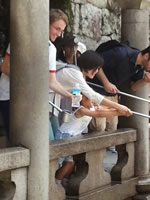
Ben Ten embracing the identity of “that American tourist” by filling up a water with the holy waters of Kiyomizu Dera in Kyoto.
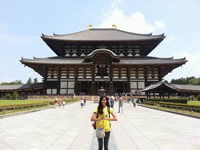
Posing in front of the Todai-ji Temple in Nara which houses an impressive Daibutsu.

Posing in front of the beautiful Kegon Waterfall in Nikko
Research Update
Again this week I have been working on gathering data from my programs. I hit some snags because I did not realize that as I increased crystal size some of my values were exceeding the limitations of the UInt16 data type in C#. Therefore, I was getting very bizarre trends. Therefore, I simply changed some of the data types to double and now they are working much better. Therefore, I am continuing to generate graphs of the stacking fault density and stacking fault edge density as a function of thickness of the crystal. I am also working on my poster, the presentation for the Tokyo Symposium, and finally the presentation to my lab next Thursday which I am a bit nervous for.
The trends I am getting for stacking fault reduction reflect our predictions in some ways but not in others. As expected, the stacking fault density decreases much more rapidly along the (111) face. However, it then plateaus and only reduces to 0 at about the same thickness as that of the (001) face.
Nagasawa-sensei has asked me to also plot the stacking fault density for a crystal of infinite thickness. This is sort of what I was worried about because the periodic boundary conditions don’t really work with the triangular geometry I have chosen for the (111) face. But, he said that it might be okay to model it with a square geometry just so that we can get some results to look at.
I think the project is wrapping up pretty nicely, but it is definitely going to be a busy last week. I still need to gather a fair amount of data while putting the finishing touches on my poster and putting together what I hope will be a pretty stellar final presentation for my lab.
There has been a lot that has surprised me about Japan, but I think what has been the most salient is how kind and good-natured the people are. So many of the people that I have met here have gone out of their way to make sure that I am happy and comfortable. At least where I am from in the US, people can be very non-confrontational and abrasive towards strangers. This probably has a lot to do with the “stranger danger” mentality that has been indoctrinated into us from childhood. In Japan, however, I think there is less of that fear and a greater willingness to come to the side of a complete stranger when they seem in need of help.
Additionally, and I think this is simply a product of being born in America, I’ve always sort of had the belief that the U.S. was the best place to grow up. I’ve realized however that America is not exclusively the “Land of Opportunity” and that other cultures very strongly encourage “chasing your dreams” in the same way that Americans do.
In terms of personal growth, I think this summer has made me significantly more independent. I could not really sit back and let someone else take care of me because there was no one to do that. Therefore, I had to take the initiative to do things like plan out trips to the Kansai region or find language classes in Sendai. This summer has also made me more adaptable! True to the spirit of being a college student, I have slept on floors, couches, and eaten my fair share “protein-bar-dinners” during our low-budget excursions around Japan. Finally, it has definitely made me more adventurous. I find myself entering into new crowds assuming the people there are worth getting to know and entering into new situations assuming they are worth exploring. This mindset is new for me, but it helped me explore Japan to its fullest. Moreover, working in Japan really is making me reconsider my plans for the future. I never really pictured myself living anywhere other than the U.S. until coming here. I can now imagine what it would be like to live, work, or study in a different country and it is pretty appealing. At the very least, I think I will be much more aggressive about pursuing other opportunities like NanoJapan.
This week has not-so-surprisingly been pretty emotional. I had my going away party on Wednesday during which each member of my lab said their own personal goodbye to me. Then, I had my turn to try to summarize just how they have all made this the best summer of my life. I left my lab members with several copies of the brochure and invitation for a special dance performance I did when I was 16. It was probably one of the most important days of my life, so I was happy to share something that special with them. Then, on Thursday, I had my last language class with the lovely Otomo sensei, thanks to Vernon’s prodding, the last class also involved an impromptu dance performance which Otomo sensei really appreciated.
I closed out my project with a final presentation to my lab. I essentially summarized everything that I did and everything I learned…. wuth some funny pictures I took with my labmates thrown in here and there. I will actually be keeping pretty close contact with my sensei. He will be using some of my plots for a paper that he is writing soon, and he would like me to stay on board as a co-author. This means that I will have to contribute to the writing of the paper, and as he quite often reminds me, editing the English as well! I would really like to continue working on my project when I get to Penn State. I am not sure if it will mesh well with the project I am currently involved with at Penn State, but I am really hoping that I can make it work somehow! I have realized towards the end that there are some interesting modifications that I can make in order to make the simulation more accurate.
The final weekend in Japan will be spent climbing Fuji-san with the other NanoJapaners and even one of our dorm-mates at Urban Castle. Milan from the Czech Republic has become one of our closest friends in Sendai, and he will be joining us for the ascent! It is difficult to imagine leaving Sendai. I have really fallen in love with Japan’s beautiful “City of Trees.” It has been a wonderful place to live- very easy to get around, but packed with different things to do at the same time.
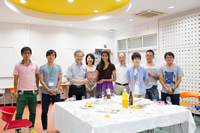
My (all vegetarian!!) going away party. We shared a lot of laughs that night, but it was certainly difficult saying goodbye.
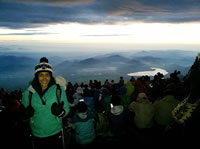
On the summit of Fuji-san, bearing the frigid cold as we waited for the sun to rise. Once it did, the crowd on the summit exploded into cheers and cried out a loud, heartfelt “Ohayo gozaimasu!!”
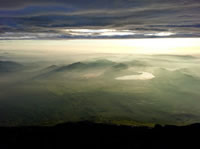
The heavenly view from Mt. Fuji!! To future NanoJapaners, this is not something you want to miss out on!!
Research Symposium in Tokyo
Presenting the research posters at the NanoJapan Research Symposium in Tokyo was an enjoyable experience, although challenging in its own right. However, the difficulty had a lot to do with the fact that each of us had just completed an overnight hike of Mt. Fuji and really had the wind knocked out of us. But, it was also a real challenge explain our research and explaining the significance of NanoJapan in just about 5 minutes.
The symposium was unique in that it had a two-fold purpose because it encompassed both terahertz physics and devices as well as international collaborations in science. As such, we ended up hearing from scientists, education specialists, and representatives from government. What stood out to me about the symposium is that it allowed the audience to compare American and Japanese perspectives on the same issues. For example, it was brought to light that the setup of national Japanese science organizations are not conducive to supporting international research exchanges for students. This is because there are three separate organizations which each wear different hats. There exists a great deal of bureaucracy in their dealings.
Additionally, I learned that there are differing attitudes in students’ perception of studying abroad. Many Japanese students are uncomfortable with the prospects of studying abroad because it means time away from home, it is not cost effective, and they feel it is not attractive to employers! Contrarily, many American students actively seek opportunities to study abroad. I know that at many US universities, many STEM students lament the fact that they do not have enough time or opportunities to study abroad. Therefore, it was particularly exiting to discover opportunities like NanoJapan because they allow one to utilize his/her summer to engage in both professional development and cultural excursions.
Final Research Overview
Project
Title: ![]()
Host Lab: Solid State Electronics Lab, Prof. Maki Suemitsu, Tohoku University
Mentors: Hiroyuki Nagasawa and Keiichiro Tashima
Introduction: 3C-SiC is a wide-bandgap material that has attracted interest for high temperature, high frequency, and high voltage applications. The hope is that scientists will be able to incorporate it into power-switching MOSFET devices in the motor drives of electric vehicles since it has a high enough breakdown voltage as well as a high carrier mobility in MOSFET devices. Another major benefit of 3C-SiC is that its synthesis processes are compatible with that of Si which can help drive down production costs. However, owing to the 19.7% lattice mismatch between 3C-SiC and Si, many stacking faults nucleate at this interface in order to reduce the number of dangling bonds. Therefore, my project is centered on modeling the generation and propagation of stacking faults during the epitaxial growth of 3C-SiC on a Si substrate. We used Monte Carlo methods to study the stacking fault reduction methods along both the 3C-SiC(001) and the 3C-SiC(111) faces. These simulations are important because it is an arduous process to observe stacking fault density experimentally and no work has gone into comparing stacking fault interactions between the two orientations thus far.
Approach: We utilized a simple Monte Carlo algorithm to study the behavior of these stacking faults. Essentially, this means that each new configuration in the simulation was generated randomly. This randomization was simply biased by parameters entered by the user and specifications set in advance to assure that the simulation is physically accurate.
We created separate programs for the 3C-SiC(111) face and the 3C-Sic(001) face since each have a different geometry. Then, we ran both simulations with the same initial parameters so that we could compare the results.
Results and Discussion: The results we generated were plots of stacking fault density and dislocation density as a function of crystal thickness. We generated data for both the (001) and (111) orientations and also varied the crystal size to investigate these impacts.
We confirmed that stacking fault density will decrease with increasing crystal thickness and decreasing crystal area size. Additionally, there is a rapid decrease in stacking fault density when the thickness is approximately equal to the dimensions of the crystal. Finally, we observed different trends in 3C-SiC(001) and 3C-SiC(111). There were more rapid decreases in stacking fault density in 3C-SiC(111). In contrast, for 3C-SiC(001), there were sharp initial decreases and then it would plateau a bit.
Future Research: Some of the stacking faults in this system are Shockley type which means that they are terminated by mobile dislocations capable of gliding along one of the four equivalent {111} planes in 3C-SiC. The glide of these dislocations can impact the size of the stacking fault. Therefore, in the future, the model can be made more comprehensive by incorporating 3D mapping of partial dislocations, classifying them as mobile or immobile dislocations, and then incorporating the impact of dislocation glide into the simulation.
Conclusion: Experimentally determining stacking fault density over the course of epitaxial growth would involve taking several cross sections of a sample and counting the stacking faults with the aid of a transmission electron microscope. However, this simulation tool offers a glimpse of stacking fault interactions during epitaxial growth. In this study, we demonstrated the differences between 3C-SiC(001) and 3C-SiC(111) epitaxy as well as the impacts of crystal size.
At the beginning of the summer, I thought it was a bit of a weird anomaly for the NanoJapan Program to target first and second year students specifically. I would know as well as anyone that this is quite rare because I’ve perused many, many summer internship websites. Not surprisingly, many target upperclassmen because they bring a level of expertise and experience. However, now having completed the program, I can see that it probably had the maximum benefit for me right here and right now. The impact that this summer program has had on my life is certainly multifold.
If I were describing NanoJapan’s impact on my life to my family members, I would say that NanoJapan really taught me compassion. A highly unique aspect about Japan was the ubiquitous level of compassion and consideration among the population. The low crime rates and general peace and accord that existed even in the busiest districts of the city were reflections of this. Perhaps as a function of the homogenous culture, people feel a mutual cultural understanding that prompts them to treat one another fairly. I have thought a lot about whether something similar exists in the US and if not, why? Even though we do not often recognize it, being “American” really is a cultural identity and this is something that I have learned while living in abroad. Here in the US, I do believe that we all have a shared understanding of what it means to respect a person, but we do not always make it a point to act accordingly. I think living in Japan has made me much more conscious of my interactions with people and the impressions I make on people based off of my words and actions.
If speaking to an employer, I would say that my experience in Japan has made me a much more independent researcher. Often when I was assigned tasks to complete in lab, they would either be highly open-ended or I would not entirely understand the parameters of the assignment as a function of the language barrier. This could have completely immobilized me in my work and I could have wasted weeks on end sitting and waiting confused. However, I would often take these opportunities to try to think of a creative solution to the issue as I understood it. Because I was doing a computational project, I was able to work pretty liberally without worrying about exhausting resources. This allowed me to progress through my project at a very rapid rate. At each stage of my progress, I would report back to my sensei, and he would often help me make the adjustments I needed to make to assure that I was meeting all the requirements of the model.
If speaking to a professor, I would discuss NanoJapan in terms of its value as a scientific learning experience. After the many lab tours, nanotechnology seminars, and my internship, I learned more than I could have realized in three months. Now that I have returned home, I have begun to glance at the textbooks for my classes this semester on electronic materials and devices. The lessons on bandgap theory, p-n junction formation, and spectroscopic analysis of materials all seem like a review after this summer. Additionally, I felt particularly lucky because my sensei offered me personalized lectures that dealt with the subject of my research. Therefore, I gained a pretty exhaustive background on defects in 3C-SiC. For this reason, I am really interested in utilizing my research in the completion of my undergraduate thesis and I am currently looking for professors at Penn State who will help me to do so as a thesis advisor.
If speaking to a student at Penn State, I would say the most important thing I learned from NanoJapan was how to be bold and tenacious. The program yanked me out of my comfort zone - and not gently. The program sort of equips you with all of the necessary safety equipment and then pushes you right out of the plane. And this worked well! It was the first time I really had to take care of myself, cook for myself, and work out my own travel plans and accommodations. Moreover, I was doing all of this in a foreign country! However, if I ever felt stressed or uncomfortable, there was a big safety net in place and many different people whom I could contact for help. But as a result of this, I have learned to become much less reliant on others and recognize the fact that unless I step up to plate and seek out unique experiences, I will miss out on a lot.
Having lived in Japan this summer has made the world feel a lot smaller and much more accessible. I am now planning on pursuing a research abroad or study abroad opportunity during my senior year of college. In fact, I am very eager to apply for an internship at OIST because there were a few different labs which we visited during the lab tours that piqued my interest. Additionally, inspired by my experience with NanoJapan, I have registered for Japanese in this upcoming semester! I did not want my language study over the summer to go to waste. I have also realized that Japan is a superpower in nanotechnology and materials industries. Therefore, if I wish to pursue research in either of these domains, I think it would be wise to study my Japanese.
Finally, and this may seem silly, but my burning question about Japan concerns the produce. Why is it so expensive and why do the fruits and vegetables look so perfect that they all just seem to be genetically engineered? The countryside in Japan just seemed to be so green and luscious and dense, so why not farm a more diverse crop than simply rice, tea, and mushrooms? Do many fruits and vegetables simply not grow well in Japan or are they just not cultivated because they are not staples of the Japanese diet? It was quite shocking to have to pay 200 yen for an apple or 5000 yen for a melon! Even if much of the produce has to be imported, I still cannot understand why it was so expensive. It seemed like a really curious anomaly.